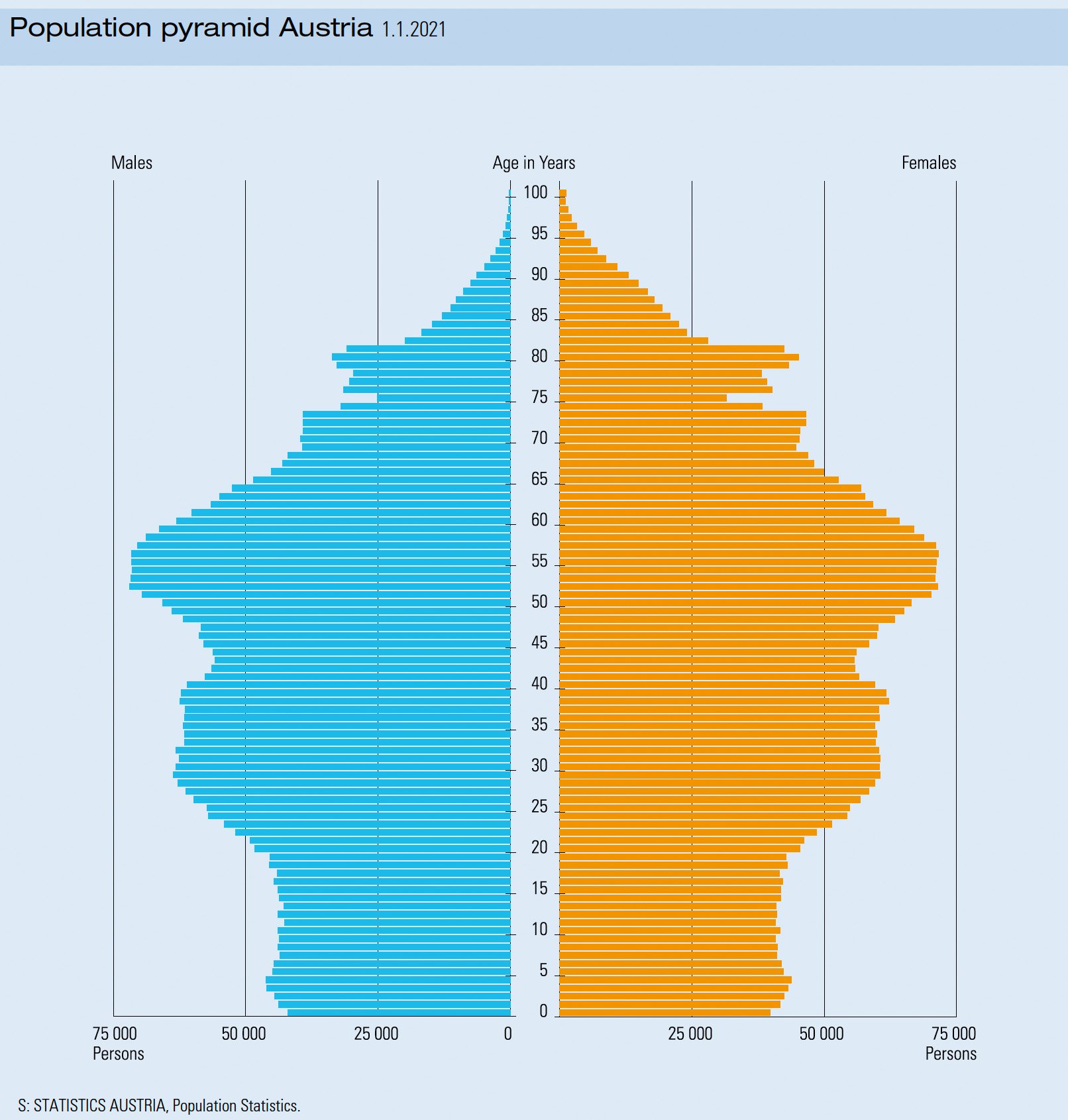
Population
Population
Around 1900, close to 6 million people were living in Austria (within its present-day borders). The 7 million mark was reached in
the late 1950s. In 2000, Austria’s population has surpassed the 8 million mark. At the be- ginning of 2021, 8.93 million inhabitants were registered in Austria. According to current population projections, the figure is expected to reach 9.94 million by 2080. The municipality with the largest population is Vienna, which had 1.92 million residents at the beginning of 2021. A fifth of Austria’s population thus lives in the federal capital. Next come the provincial capitals Graz (291 000 residents), Linz (207 000 residents), Salzburg (155 000 residents) Innsbruck (131 000 residents) and Klagenfurt (102 000 residents).
There are also some very small municipalities in Austria. A total of six municipalities had less than 100 inhabitants at the beginning of 2021. The smallest municipality is Gramais in Tyrol with 41 citizens, followed by Namlos (Tyrol, 65 residents), Tschanigraben (Burgen- land, 67 residents), Kaisers (Tyrol, 78 residents), Hinterhornbach (Tyrol, 94 residents) and Spiss (Tyrol, 99 residents).
The age pyramid, a mirror of history The history of the 20th century has left its mark on the present-day age pyramid. There are many more women than men not only in the highest ages but generally in all age groups beginning with the age of 59. This is due to the longer life expectancy of women.
Though the small numbers at the top of the population pyramid can be traced back to the deficit of births in World War I. In contrast, the number of children increased rapidly after the Anschluss to the Third Reich in 1938. Persons born at that time are now around 79 to 81 years old. At the end of World War II as well as in the early post-war era, the birth rate dropped again, which in the pres- ent-day age pyramid is illustrated by “notch- es” along the ages of 74 to 78. The largest cohorts were born in the 1950s and especially the 1960s. This Baby Boom Generation also increased through immigration. As a conse- quence of the post-Baby Boom reduction in birth rates, which has only been partially compensated by immigration, the base of the population pyramid is comparatively narrow.
Of the 8.93 million residents of Austria, about less than 1.29 million are children under 15 years of age. About 5.93 million are in the 15 to 64 year range, and another 1.72 million Austrian men and women are 65 years or older. This means that 14.4% of the population are preschool and compul- sory school age children, about two thirds (66.4%) are of working age, and 19.2% are elderly persons in retirement age.
The number and percentage of the senior population of 65 and older is increasing, henceforth even more, as the Baby Boom Generation reaches retirement age in the foreseeable future. The potential workforce is remaining relatively stable; however, the population of working age is also ageing
Demographic Trends
The Austrian population is growing almost exclusively through immigration: Every year there are considerably more people migrating to than emigrating from Austria. In contrast, the numbers of births and deaths are usually more balanced. 97% of Austria’s total population growth between January 1st, 2011 and January 1st, 2021 (+557 500 people) can be attributed to net migration gains (+539 905). The surplus of births was comparatively low in this period. In 2020, the first year of the COVID-19 pandemic, the number of births was even lower than the number of deaths (-7 996). The last time this had happened was in 2012 (-484) and 2013 (-196). Based on 136,343 immigrations and 96,279 emigrations, the net-migration gain in 2020 (+40 064) was similar to 2019 (+40 613).
In 2020, there were 39,662 marriages in Austria. More than two-thirds (70%) were first-time marriages, in other words, both partners had never been married before. Nearly one-third of all marriages are remarriages, i.e., at least one of the partners had been married before.
37% of marriages end in a divorce
In 2020, 14,870 divorces were recorded. If divorces are related to the number of marriages of their corresponding marriage years, 37% of all marriages got divorced. In most cases (87%), divorces were amicable. While the number of naturalizations in Austria has increased between 2010 and 2019, the naturalization rate has stagnated around 0.7% during this time. In 2020, this number dropped to 0.6% (8,769 naturalizations).
Today 100 women have an average of 144 children. In order to replace the parent generation, however, slightly more than 200 children (2 children per woman) would be required.
Nearly one-third of all marriages are remarriages, i.e., at least one of the partners had been married before.
Foreign Citizens
As a consequence of immigration, the number of persons with foreign citizenship rose sharply in the early 1990s and again in recent years. At the beginning of 2021, there were more than 1.53 million citizens of foreign countries living in Austria, and they accounted for 17.1% of the total population. In 1985, about 297,000 or 3.9% of the total population were foreign citizens. During the 1980s, this number remained relatively stable. Increased immigration at the beginning of the 1990s led to a higher number and percentage of the population with foreign citizenship. By 1994, the number of foreigners totalled around 665 000 and thus represented 8.4% of the total population. From the mid 1990s, this number and percentage stagnated; since 2001, however, it has been increasing again.
In total, 793,000 citizens from other EU-countries live in Austria, representing 52% of all foreign citizens in Austria. The biggest group among EU-citizens are 209,000 Germans, followed by Romanian (132,000), Hungarian (91,000), Croatian (89,000) and Polish citizens (67,000). 122,000 Serbs, 118,000 Turks and 97,000 citizens from Bosnia and Herzegovina represent the three largest communities of nationals from outside of the European Union.
The community of non-European citizens in Austria accounts for 196,000 citizens from Asia (excluding Turkey and Cyprus), including 55,000 Syrian nationals as well as 44,000 Afghans. About 36,000 people hold citizenships of African and 24,000 of American countries. 1,600 are citizens from Australia and Oceania.
More than half of all foreign citizens are from another EU country.
Since 2009 Germans are the largest group among foreign citizens in Austria.
Within the EU, only Luxembourg, Malta and Cyprus have higher shares of foreign citizens than Austria.
2.5 Million Families
The Austrian population lives in 3.99 million private households. Only a small fraction of the population, around 135 000 persons, lives in one of the 3 400 institutional households, most of which are retirement homes. 1.51 million households, or around two in five households, are single person households. They represent 17% of Austria’s population. Only a small fraction of all single households consists of young persons. The majority are elderly people, in particular women, who have remained single after the death of their spouses.
Among the households with more than one person, there are 2.46 million families. These are married or unmarried couples with or without children as well as single parents with their children, provided that they live in a joint household.The number of families with children totals 1.4 million and thus 57% of all families. 1.06 million couples do not have children living in the same household.
However, only a small fraction of these are young childless couples. Most are older couples whose children have left the joint household. Around 71% of all families are married couples (with or without children), 17% are cohabiting couples. 12% of families are lone-parent families, the vast majority of them (84%) with a lone-parent mother.
17% of the population live in single person households; most of them are widowed elderly women.
84% of all lone parents are women.

